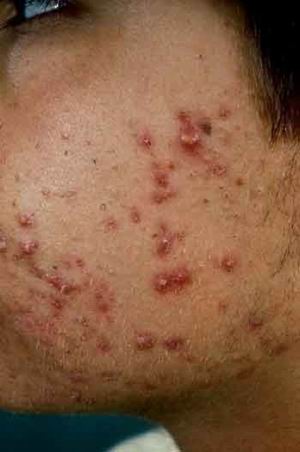Acne Information
Click here to scroll to the list of available medications ↓
Acne is a very common skin condition. While not technically a disease, acne affects more people than most other serious and common health conditions and diseases. Four out of five people will experience acne, from mild to severe, and while most people associate acne as a teenager condition, people of all ages can be seriously affected by acne. Acne can occur on the face, neck, arms, back, chest, and occasionally the abdomen.
The signs and symptoms of acne are obvious, as it appears a blemishes and tiny infections on the skin’s surface. Acne can attack in the form of white heads which are a symptom of the hair follicle becoming clogged with normal oil secretions and dead skin cells. They are called white head because the infectious pus inside creates a white surface on the top of the pimple.
Blackheads are very similar to a whitehead, only instead of whitening the skin surface stays open and darkens, creating a tiny black spot on the surface of the skin. It is rare for blackheads to swell and become raised from the surface of the skin, although it can happen.

Pimples are an infection of the hair follicle, often surfacing as a raised, red and swollen bump on the surface of the skin. Pimples are the most common form of acne.
Cysts are more painful, more noticeable and last longer than any other form of acne. They are very thick lumps that linger just below the surface of the skin. The infection associated with a cyst is deeper in the hair follicle. They tend to be quite large and can swell, redden, and often rupture under the skin’s surface if squeezed.
While there are numerous theories and old wives’ tales about why pimples and acne occur, the most accurate cause is bacteria. Bacteria that is unique to the skin builds up beneath the surface of the skin, and sometimes with the help of oil secretions and irregularly large amounts of dead skin cells, cause an infection inside the pores. Despite what many patients were told as children, premature sex, stress, masturbation, and chocolate do not cause acne.
Hair follicle cells and pores are the only ones that are affected by acne. Pores that are involved in sweat production do not typically become infected. This is because the hair follicles deliver and secret oils that can become trapped in the skin’s pores and cause a plug. A plug is what clogs the pore in the first place producing the infection around it.
Hormones, bacteria build up, medications, and heredity do contribute to cases of acne. In an otherwise healthy individual who is not medicated with acne causing medications, eliminating the bacteria from the pores once or twice daily can effectively clear up the acne, although small and tolerable break outs may occur during hormonal changes such as pregnancy or menstruation.
Risk factors for acne can include, entering adolescence, women and girls experiencing hormonal changes anywhere from two to seven days before the onset of menstruation, pregnancy, and patients who use cortisone and other medications. Friction in the skin, irritating the skin with abrasive chemicals or harsh cleansers, irritation caused by sun exposure, family history, exposing the skin to oily and greasy substances, such as car grease, cosmetics, and cleaning agents can also contribute to the development of acne.

There are no physical complications from acne, although the emotional, psychological, and social complications can be tremendous. Patients with severe acne tend to have self esteem problems, regardless of their age. Acne can feel like a gigantic statement of isolation.
Acne treatments are generally aimed at reducing bacteria, clearing out dead skin cells and advancing the speed at which skin cells reproduce, and reducing oil production. Treatments that focus on all three combination causes are the most effective.
Topical treatments, such as over the counter washes and lotions can be effective at clearing up mild to moderate acne. Lotions and topical treatments that contain benzoyl peroxide, salicylic acid, and lactic acid are considered most effective. In generalized acne polls, the vast majority used either a combination of salicylic acid and benzoyl peroxide or benzoyl peroxide alone found the most effective acne treatments.
Some acne will not respond to over the counter topical treatments and require a dermatologist to evaluate their skin and prescribe prescription medications to treat acne. Medications such as Differin and Tretinoin can be prescribed by a physician. Many topical treatments, even prescription strength medications will cause the skin to worsen before it improves.
Antibiotics are sometimes prescribed for severe acne cases, although antibiotics may need to be taken long term and used in conjunction with topical treatments. Antibiotics are aimed at clearing the bacteria that causes acne. A medication known as Isotretinoin can be very effective at clearing up even the worst acne, but carries a high level of risks of side effects, including birth defects. Women who are of average reproductive age are required to participate in FDA monitored programs to be sure that their program does not allow for pregnancy while undergoing treatment. High cholesterol and triglycerides are other potential side effects. Isotretinoin is rarely used despite its effectiveness for this reason.
There are surgical procedures available to help diminish the appearance of acne scars, although not all patients will benefit. Skin that is easily scarred may actually become worse with some cosmetic surgical procedures.
Coping with acne can be very difficult, for teenagers and adults alike. Finding a dermatologist or a topical treatment that works can be life changing. Finding ways of coping with acne can be nearly impossible, and a strong support system and people who validate the patient on an emotional level can make a significant difference.